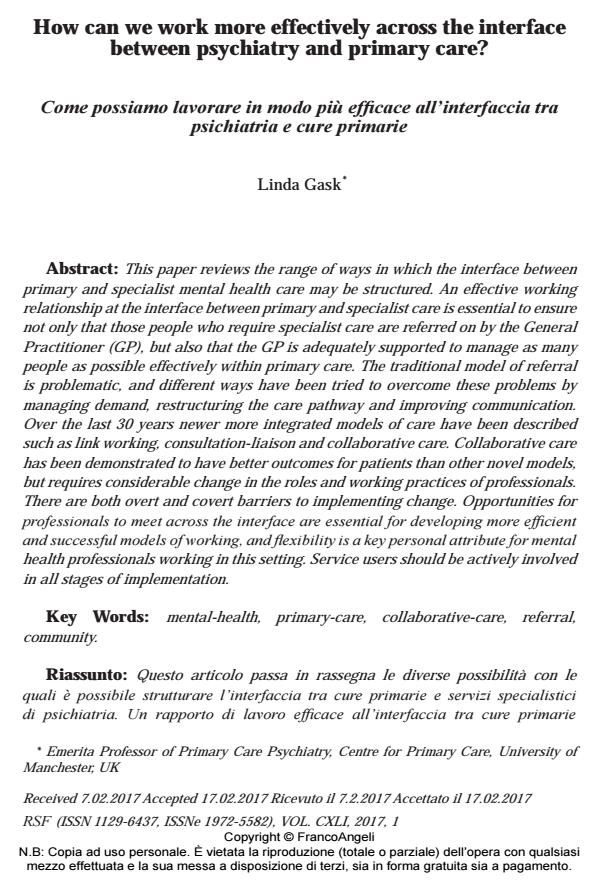How can we work more effectively across the interface between psychiatry and primary care?
Titolo Rivista RIVISTA SPERIMENTALE DI FRENIATRIA
Autori/Curatori Linda Gask
Anno di pubblicazione 2017 Fascicolo 2017/1
Lingua Inglese Numero pagine 20 P. 107-126 Dimensione file 1728 KB
DOI 10.3280/RSF2017-001008
Il DOI è il codice a barre della proprietà intellettuale: per saperne di più
clicca qui
Qui sotto puoi vedere in anteprima la prima pagina di questo articolo.
Se questo articolo ti interessa, lo puoi acquistare (e scaricare in formato pdf) seguendo le facili indicazioni per acquistare il download credit. Acquista Download Credits per scaricare questo Articolo in formato PDF

FrancoAngeli è membro della Publishers International Linking Association, Inc (PILA)associazione indipendente e non profit per facilitare (attraverso i servizi tecnologici implementati da CrossRef.org) l’accesso degli studiosi ai contenuti digitali nelle pubblicazioni professionali e scientifiche
This paper reviews the range of ways in which the interface between primary and specialist mental health care may be structured. An effective working relationship at the interface between primary and specialist care is essential to ensure not only that those people who require specialist care are referred on by the General Practitioner (GP), but also that the GP is adequately supported to manage as many people as possible effectively within primary care. The traditional model of referral is problematic, and different ways have been tried to overcome these problems by managing demand, restructuring the care pathway and improving communication. Over the last 30 years newer more integrated models of care have been described such as link working, consultation-liaison and collaborative care. Collaborative care has been demonstrated to have better outcomes for patients than other novel models, but requires considerable change in the roles and working practices of professionals. There are both overt and covert barriers to implementing change. Opportunities for professionals to meet across the interface are essential for developing more efficient and successful models of working, and flexibility is a key personal attribute for mental health professionals working in this setting. Service users should be actively involved in all stages of implementation.
Questo articolo passa in rassegna le diverse possibilità con le quali è possibile strutturare l’interfaccia tra cure primarie e servizi specialistici di psichiatria. Un rapporto di lavoro efficace all’interfaccia tra cure primarie e specialistiche è essenziale per assicurare non solo che le persone bisognose di ricevere cure specialistiche siano inviate dal medico di medicina generale, ma anche che questi sia adeguatamente sostenuto nel gestire efficacemente il maggior numero di persone all’interno delle cure primarie. Il modello tradizionale di consulenza è problematico, e diversi tentativi sono stati fatti per superare questi problemi attraverso la gestione della domanda, la ristrutturazione del percorso di cura e il miglioramento della comunicazione. Negli ultimi trent’anni nuovi modelli di cura, maggiormente integrati, sono stati descritti, come il modello "link working", il modello di consultazione e collegamento, e il modello di cura collaborativa "collaborative care". È stato dimostrato che il modello di cura collaborativa ("collaborative care") ha migliori esiti per i pazienti, rispetto a modelli più recenti, ma richiede un cambiamento considerevole nei ruoli e nelle pratiche dei professionisti. Ci sono barriere sia esplicite che implicite nei confronti dell’applicazione di tale cambiamento. Le opportunità per i professionisti di incontrarsi all’interfaccia sono essenziali per sviluppare modelli di lavoro più efficienti e di successo, e la flessibilità è un attributo cruciale per i professionisti della salute mentale che lavorano in questo setting. Inoltre, gli utenti dovrebbero essere attivamente coinvolti in ogni fase di questo processo di implementazione.
Parole chiave:Salute mentale; cure primarie; cura collaborativa; consulenza; comunità
Linda Gask, How can we work more effectively across the interface between psychiatry and primary care? in "RIVISTA SPERIMENTALE DI FRENIATRIA" 1/2017, pp 107-126, DOI: 10.3280/RSF2017-001008